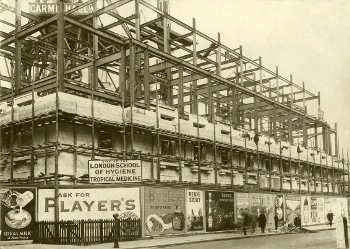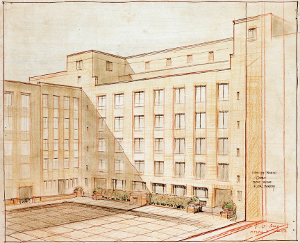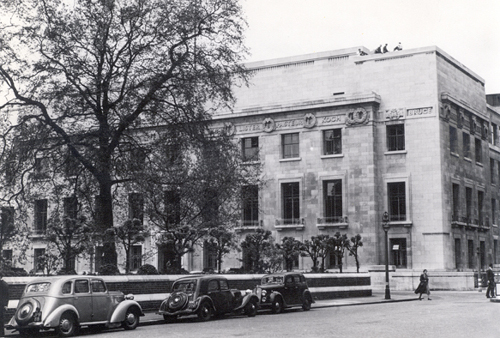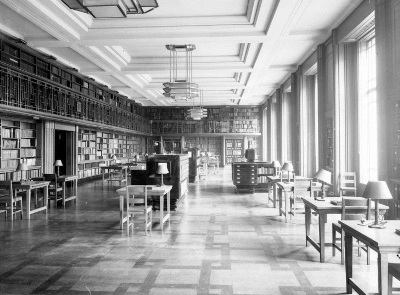Archives Hub feature for July 2016

A forgotten building that opened 100 years ago and which was a safe haven for nearly 100,000 First World War soldiers, is to be remembered at the London School of Hygiene & Tropical Medicine this summer.
Digital Drama, a UK-based media production company, was awarded a Heritage Lottery Fund (HLF) grant for the project Resurrecting the Shakespeare Hut, in partnership with the London School of Hygiene & Tropical Medicine and The Mustard Club.

The project commemorates the lives of the servicemen who used, and the women who worked at, the Shakespeare Hut, which was erected on the grounds of what is now the London School of Hygiene & Tropical Medicine’s Keppel Street site in Bloomsbury, in August 1916.
During the First World War the YMCA (http://www.ymca.org.uk/) erected over 4,000 huts to provide soldiers with food and a place to rest, either on the frontline or at home in military camps and railway stations. For the duration of the War, 35,000 unpaid volunteers and 26,000 paid YMCA staff ran the huts, serving 4.8 million troops in 1,500 canteens.
YMCA Huts were a regular sight in England, France and on all the fighting fronts during the First World War, providing a ‘home from home’ for soldiers to rest, recover and be entertained. However, the Keppel Street hut was built with a special purpose – to commemorate the 300th anniversary of Shakespeare’s death and to entertain the troops through the playwright’s work.
In the year of the 400th anniversary of Shakespeare’s death, and with the ongoing commemoration of the First World War Centenary, this is a relevant time to resurrect the Shakespeare Hut. The project will introduce the public to the Hut’s history, lift the lid on what life was like for those who used the building, and relive stories of those who fought and lived through the First World War, as well as preserving its heritage for future generations.
On 8 July an installation will open at the School, providing visitors with a chance to go back in time by stepping into a replica room – the design is taken from a photograph taken inside the original building. Images showing the Hut in action will also be on display as well as audio and visual exhibits recounting local residents’ family memories of the First World War.

At the same time, the School’s Archives Service are mounting an exhibition called The Changing Face of Keppel Street, which uses material from the archive collections to explore the history of the Keppel Street area and the development of the School’s iconic art-deco style building.
Engaging with the community and bringing people together is an essential element of the project. ‘Digital Drama’ will work with volunteers to capture local stories, and 90 students from local schools will receive valuable research and media experience by developing blogs, animations and web pages. After the installation closes, photographs and recordings will be displayed and then kept at the London borough of Camden Local Studies and Archives Centre.
Stuart Hobley, Head of Heritage Lottery Fund London, said: “In the 400th anniversary of Shakespeare, this is an ideal moment to celebrate how Britain’s most famous playwright inspired troops during the First World War. Thanks to National Lottery players, the Resurrecting the Shakespeare Hut project will record and exhibit the hidden heritage of the forgotten YMCA building and share the stories of servicemen and women during the Great War.”

The Installation and The Changing Face of Keppel Street exhibition runs from 8 July to 18 September. It will be open to the public from 9am to 5pm weekdays and for the Open House weekend – 17 and 18 September.
The School’s archives include documents, photographs, maps, publications and objects relating to tropical and infectious diseases and public health issues. The Archives also hold material on the history and development of the School since its foundation in 1899. Our collections date from the mid-nineteenth century to the present and have a global coverage.

For more information:
- visit shakespearehut.lshtm.ac.uk
- @lshtmarchives
- http://www.lshtm.ac.uk/library/
Claire Frankland
Assistant Archivist
London School of Hygiene & Tropical Medicine
Related:
Browse the LSHTM Collections on the Archives Hub
NB. the LSHTM images in this feature are from a collection not yet included on the Archives Hub but the collection description is planned to be added in the future.
All images copyright the London School of Hygiene & Tropical Medicine and YMCA Archive, reproduced with the kind permission of the copyright holders.
